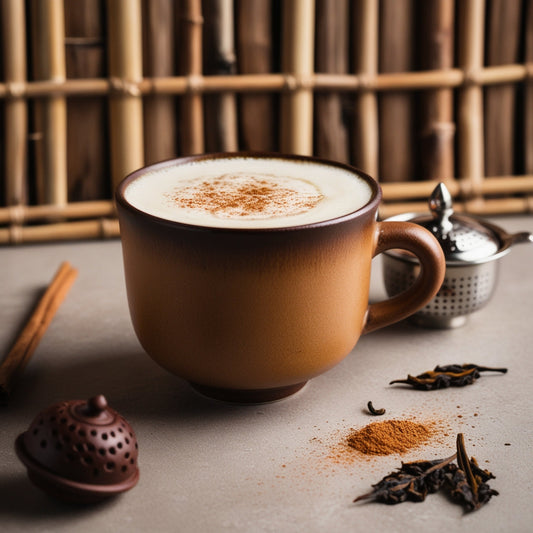Overview
Let's take you on a journey through the ancient world of Yunnan's Pu-erh, the crown jewel of Chinese teas. This article unveils why Pu-erh deserves the title of "best Chinese tea."
First, we explore Pu-erh's fascinating origins along the Silk Road's ancient tea trade routes. Next, you'll discover its unique fermentation process that transforms the tea leaves, developing a remarkable depth of flavor. Additionally, each infusion evolves, revealing layers of earthiness, sweetness, and even fruity notes.
Finally, we will find out the mysteries of Yunnan's Tea storied past, unique varieties, and captivating flavors. Ultimately, experience why enthusiasts worldwide cherish this ancient Chinese tea as the best.
Buy the best Chinese Tea from the best online seller- Pu-erh Craft.
Table of Content
- Introduction
- What Is Pu-erh Tea?
- The History of Pu-erh Tea
- The Benefits of Drinking Pu-erh Tea
- The Unique Taste of Pu-erh Tea
- The Varieties of Pu-erh Tea
- Brewing Pu-erh Tea
- Conclusion
Introduction
In the lush, misty mountains of Yunnan, a tea tradition has flourished for centuries, producing a beverage that is revered for its unique taste and remarkable health benefits.
Pu-erh tea stands out as the best Chinese tea because of its deep connection to Chinese culture and history. For centuries, people in China have cherished this tea, passing down its traditions through generations. Its unique production process and aging techniques have been perfected over time, making each cup a sip of history.
Furthermore, the complex and evolving flavors of Pu-erh tea captivate tea lovers, offering a distinctive experience that sets it apart from other teas.
What Is Pu-erh Tea
Pu-erh tea is a truly remarkable beverage, set apart from other teas by its unique fermentation process. Unlike traditional green or black teas, Pu-erh undergoes a complex aging process that can last anywhere from a few months to several decades. This fermentation process, which involves the action of beneficial microbes, transforms the tea leaves, giving Pu-erh its distinctive earthy, woody, and sometimes slightly musty flavor.

The History of Pu-erh Tea
The origins of Pu-erh tea can be traced back to the ancient tea trade routes of the Silk Road. For centuries, tea leaves from the Yunnan province were compressed into sturdy cakes or bricks, allowing them to be easily transported by caravans. During the long journey, these tea cakes underwent a natural fermentation process, giving birth to the unique taste and character of Pu-erh tea. This fascinating history has contributed to the mystique and allure of this ancient beverage.
The Benefits of Drinking Pu-erh Tea
Beyond its captivating taste, Pu-erh tea offers a wealth of potential health benefits. This tea rich in antioxidants, improves digestion, lowers cholesterol and aids weight management. Additionally, the fermentation process creates unique compounds that may aid in promoting a healthy gut microbiome. Pu-erh tea is truly a delicious and potentially beneficial addition to any wellness routine.
The Unique Taste of Pu-erh Tea
Pu-erh tea's taste is truly one-of-a-kind, a result of its unique fermentation process and the terroir of the Yunnan region. This Chinese tea offers a complex and evolving flavor profile that captivates the senses.
When you first sip Pu-erh tea, you'll likely notice its earthy and woody notes. These characteristics are the result of the tea's fermentation, which involves the action of beneficial microbes that transform the leaves over time.
As you continue to taste Pu-erh, you may detect hints of mushroom, forest floor, or even a slight mustiness. These flavors are not off-putting but rather a testament to the tea's age and the natural fermentation process.
Beneath these earthy notes, you may also discover subtle sweetness or even fruity undertones. These flavors can range from plum to date, adding a delightful complexity to the tea's profile.
One of the most captivating aspects of Pu-erh tea is how its taste evolves with each infusion. As you brew multiple steepings, the tea reveals new layers of flavor, shifting from earthy to slightly sweet, with hints of spice or even a whisper of camphor.
This ever-changing taste is what makes Pu-erh tea so intriguing and sought after by tea enthusiasts around the world. It's a tea that demands patience and attention, rewarding the drinker with a truly unique and remarkable experience.
Whether you're a seasoned tea enthusiast or simply curious about this ancient Chinese tea, exploring the unique taste of Pu-erh is a journey worth taking. Visit a reputable Chinese tea website and embark on a sensory adventure that will transport you to the misty mountains of Yunnan with every sip.
The Varieties of Pu-erh Tea
Pu-erh tea comes in two main varieties: sheng (raw) and shou (ripe). Sheng Pu-erh is the traditional style, where the tea leaves undergo a natural fermentation process over many years. Shou Pu-erh, on the other hand, undergoes an accelerated fermentation process, producing a tea that is ready to drink sooner. Both varieties offer distinct flavor profiles, allowing tea enthusiasts to explore the nuances and complexities of this remarkable beverage.
Brewing Magic
Brewing Pu-erh tea is an art form that involves mindfulness and tradition. This Chinese tea, originating from the Yunnan province, demands a careful approach to unlock its full potential. The brewing process is a ritual that allows you to savor the depth and complexity of this remarkable tea fully.
To begin, you'll need a dedicated Pu-erh tea set, which typically includes a gaiwan (a lidded cup), a fairness pitcher, and a cha hai (a tea boat). These traditional vessels are designed to enhance the brewing experience and allow you to appreciate the tea's nuances fully.
The first step is to rinse the Pu-erh tea leaves with hot water. This process, known as "awakening the leaves," helps to remove any dust or impurities and prepares the leaves for the subsequent infusions.
Next, add the rinsed Pu-erh leaves to the gaiwan and pour hot water over them. The recommended water temperature for Pu-erh tea ranges from 195°F to 212°F (90°C to 100°C). Allow the leaves to steep for a short time, typically 10 to 15 seconds for the first infusion.
After steeping, carefully decant the tea into the fairness pitcher and then into the cha hai. This step ensures an even distribution of the tea's flavor and aroma.
One of the unique aspects of brewing Pu-erh tea is that the leaves can be infused multiple times. With each successive infusion, the tea reveals new layers of flavor and complexity. Some connoisseurs recommend up to 10 or more infusions, depending on the tea's quality and age.
As you progress through the infusions, adjust the steeping time accordingly. Longer infusions may be required to extract the full depth of flavor from the aged Pu-erh leaves.

Conclusion
In the world of Chinese teas, Pu-erh stands as a true masterpiece. Its rich history, unique fermentation process, and remarkable flavor profile make it a true standout. Whether you are a seasoned tea drinker or a curious explorer, Pu-erh tea offers an experience like no other. Embrace the mystique and savor the earthy, complex flavors that have captivated tea lovers for centuries. So, why is Pu-erh the best Chinese tea? It's a journey through time, a celebration of tradition, and a delightful indulgence for the senses.
Experience the magic of Pu-erh on our website and elevate your tea drinking experience to new heights.
Q&A Section
Q1: What makes Pu-erh tea different from other teas?
A1: Pu-erh tea is unique because it goes through a special fermentation process that gives it a rich, earthy flavor. Unlike green or black teas, Pu-erh can be aged for years, developing deeper and more complex tastes over time.
Q2: Which variety should be tried first for someone who is new to Pu-erh Tea?
A2: If you're just starting with Pu-erh, we recommend trying a ripe (shou) variety first. Ripe Pu-erh has a smoother, mellower taste that many find easier to appreciate when first exploring this tea. The raw (sheng) varieties can have a more intense, earthy flavor that may take some getting used to.
Q3: What is the process of brewing Pu-erh Tea?
A3: Brewing Pu-erh is a simple process. First, rinse the tea leaves briefly with hot water. Then, steep the leaves in hot water (around 195-212°F) for 10-15 seconds for the first infusion. You can re-steep the same leaves multiple times, adjusting the steeping time slightly longer for each infusion. This allows you to fully experience Pu-erh's evolving flavors.
Q4: Are there any health benefits to drinking Pu-erh tea?
A4: Pu-erh tea is rich in antioxidants and may offer several potential health benefits. Some studies suggest it could aid digestion, reduce cholesterol levels, and support a healthy gut. However, it's always best to consult a healthcare professional for personalized advice on any potential health effects.






